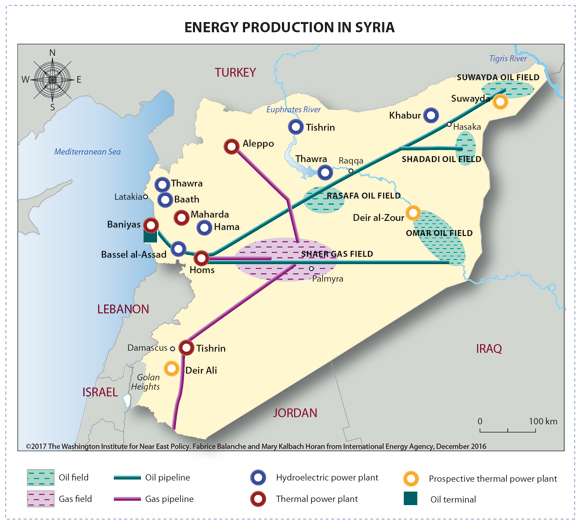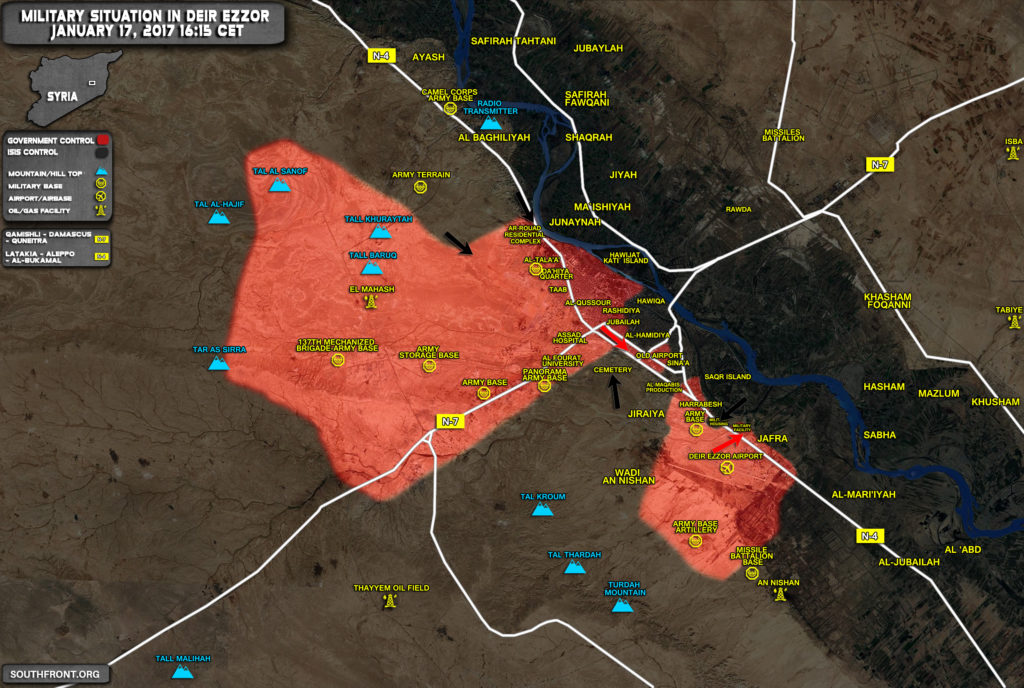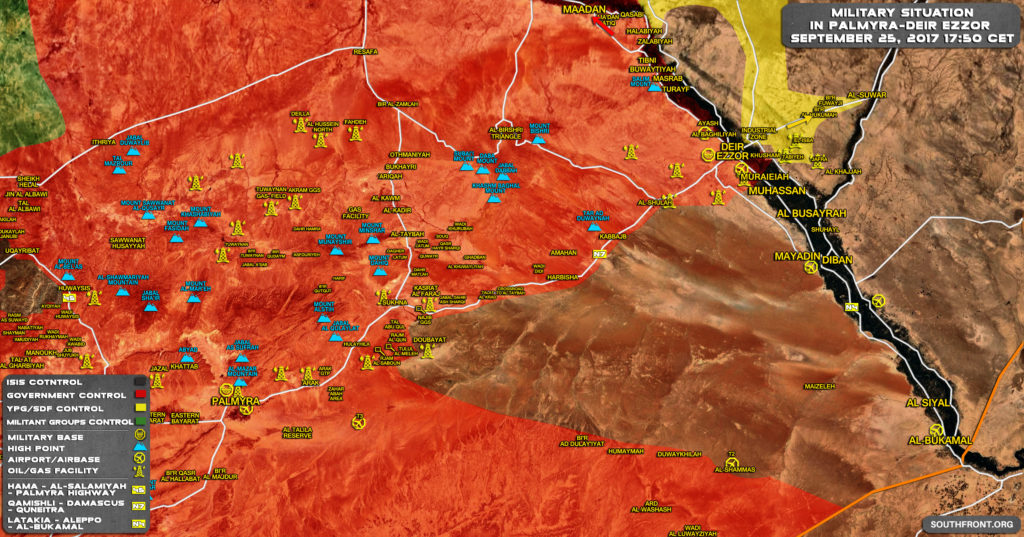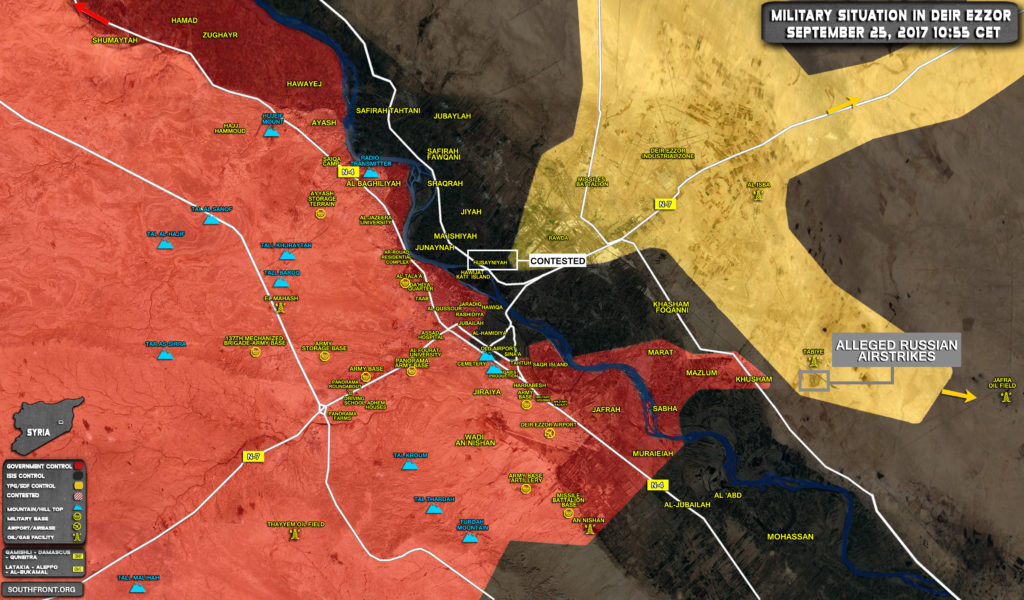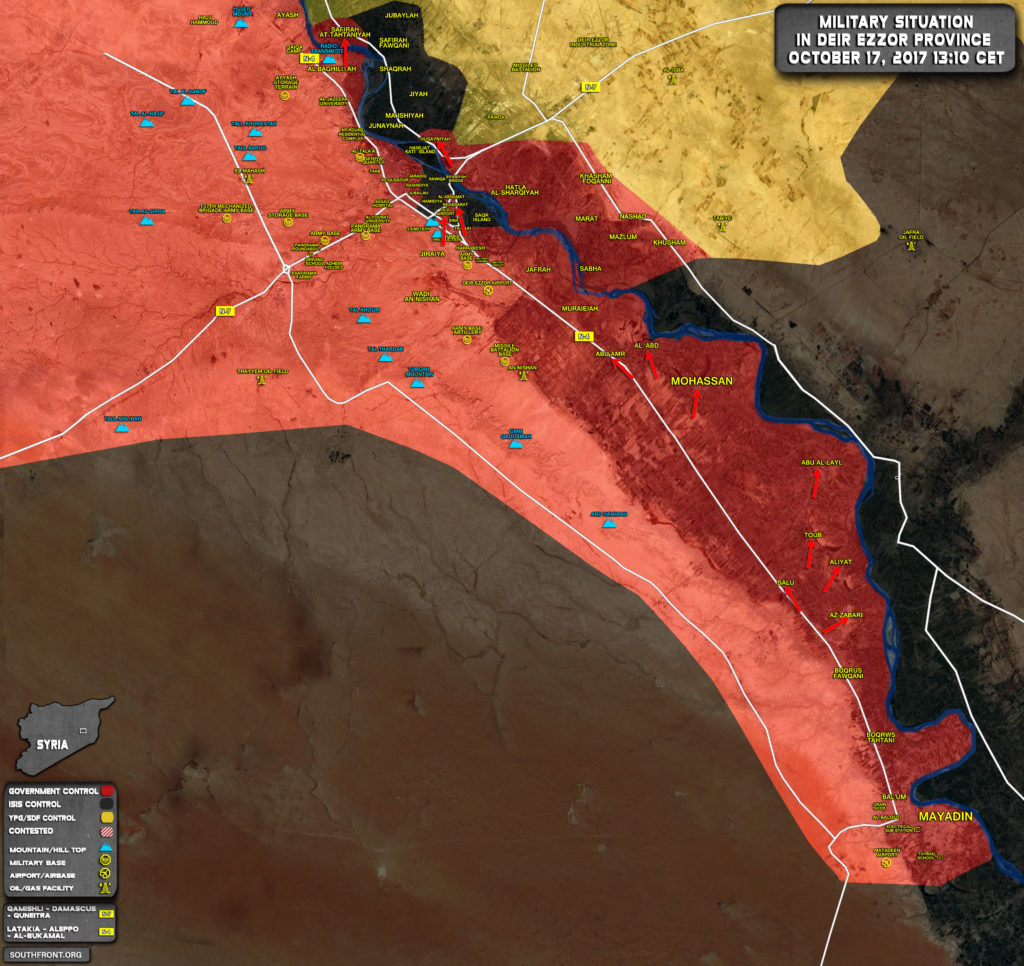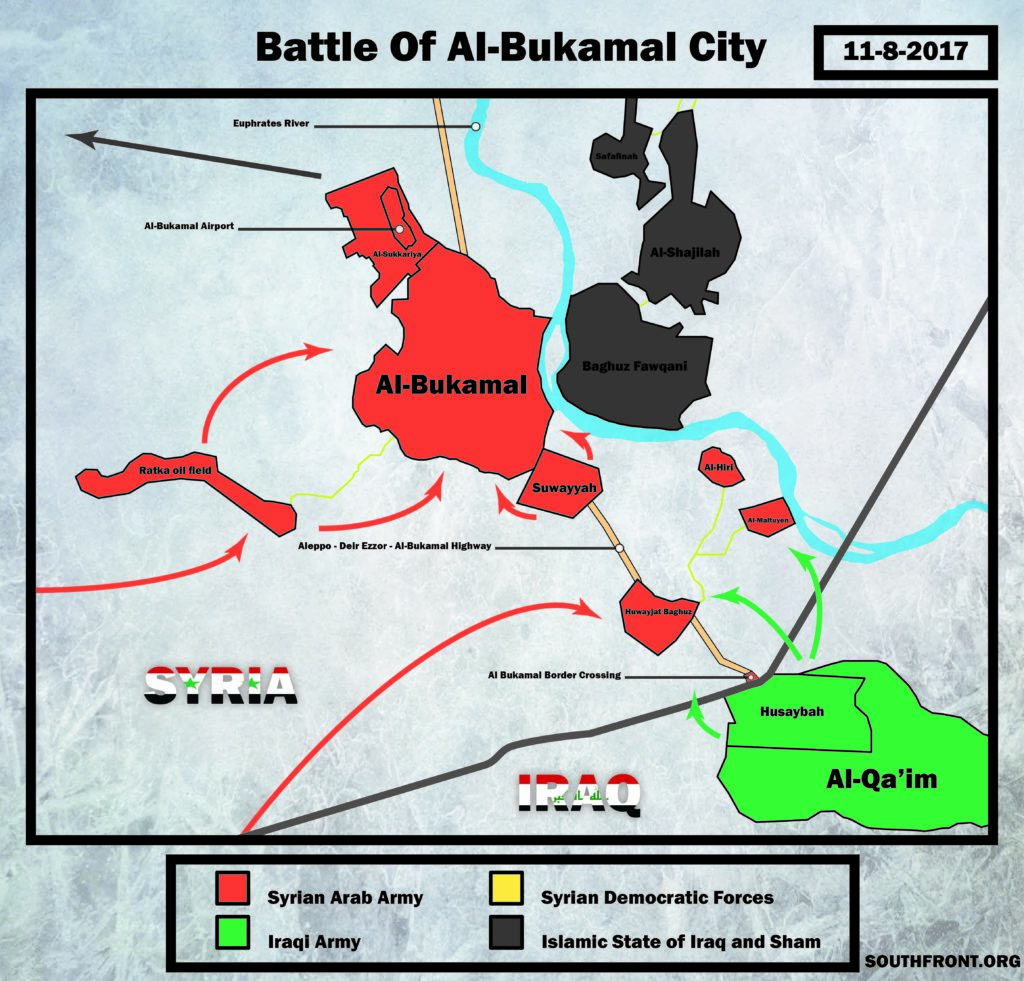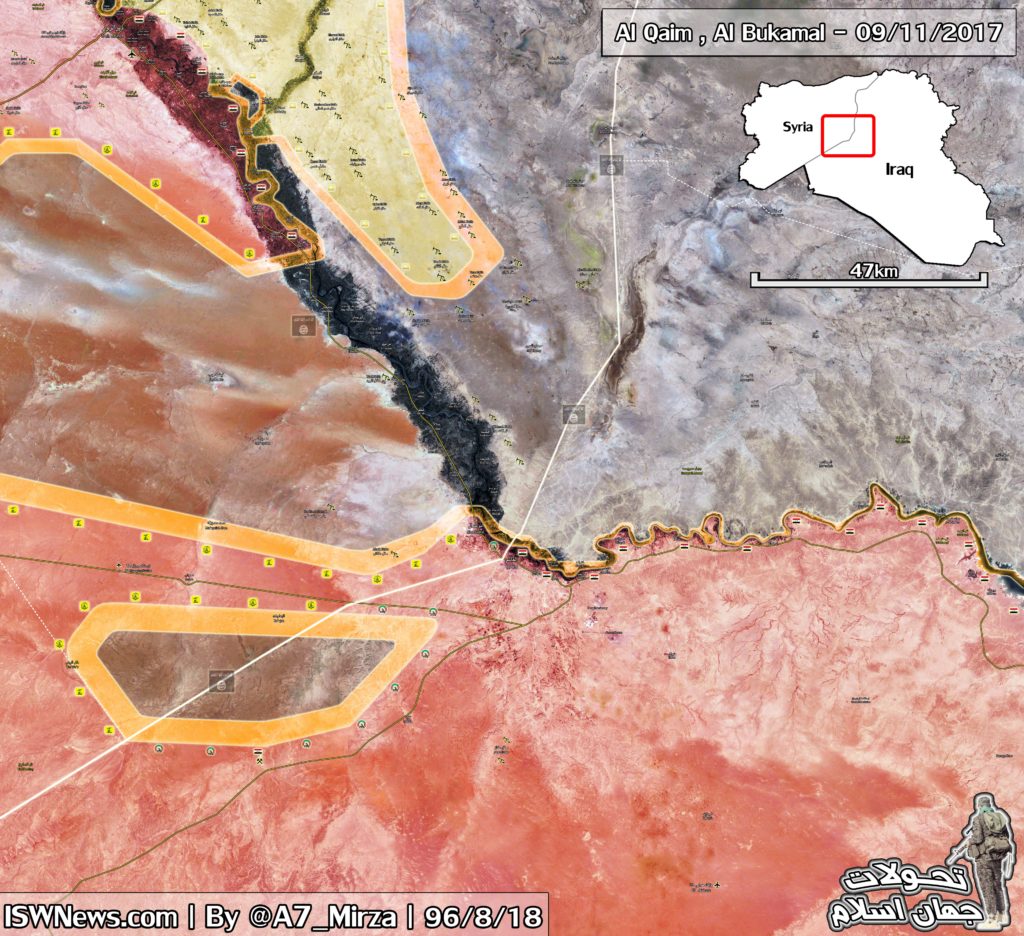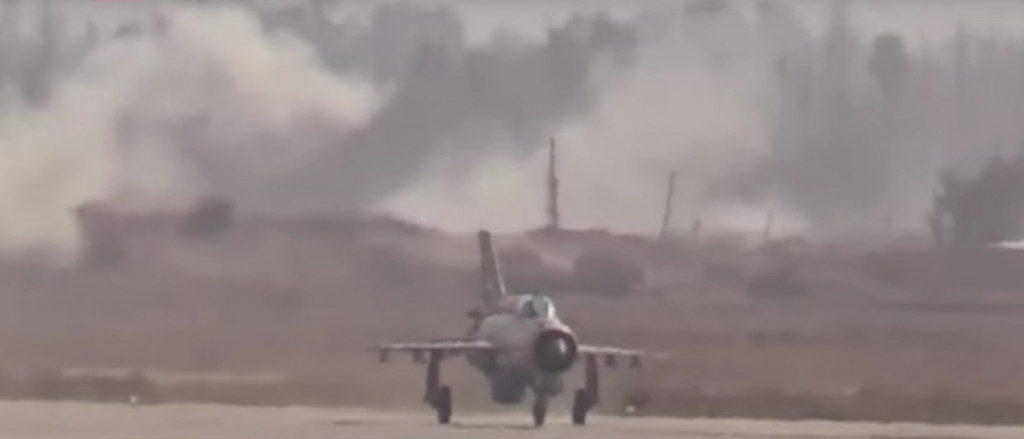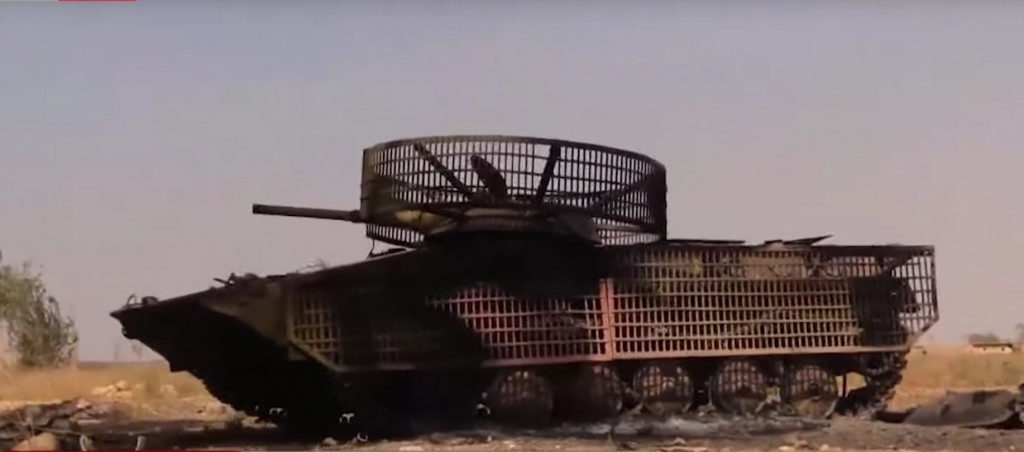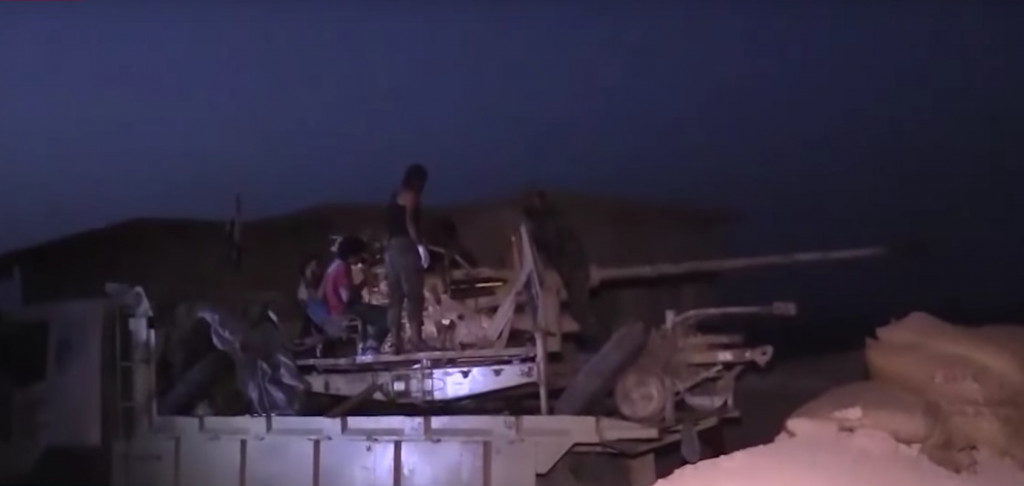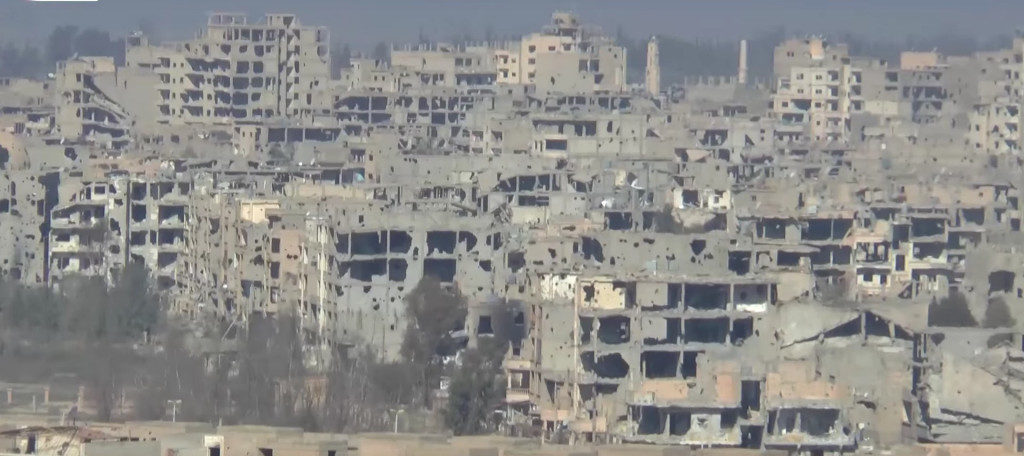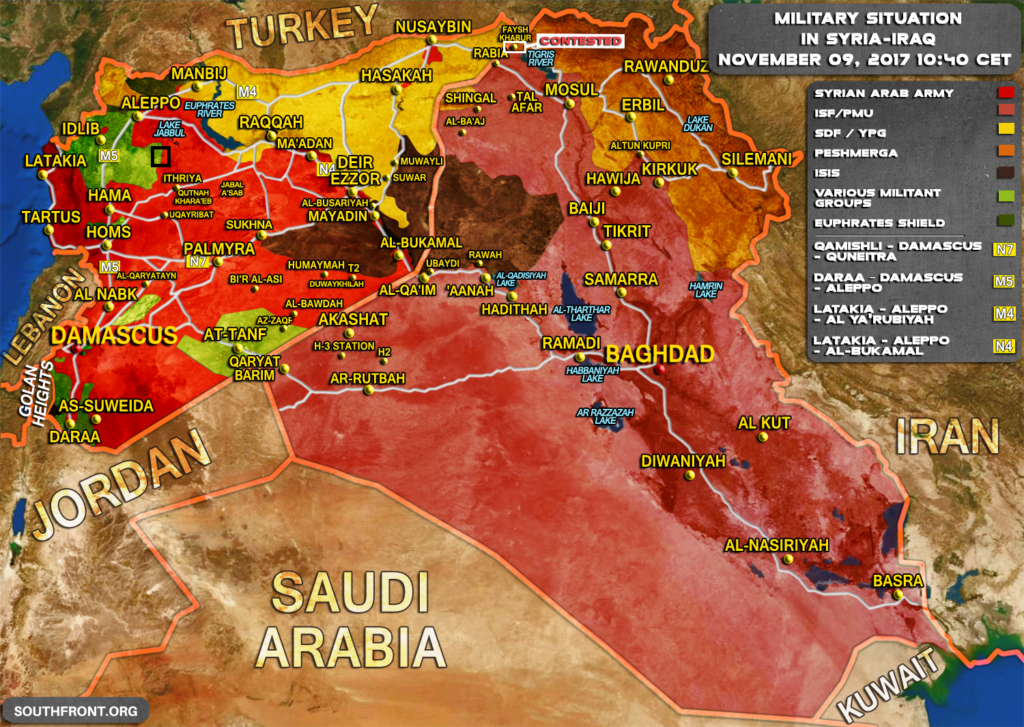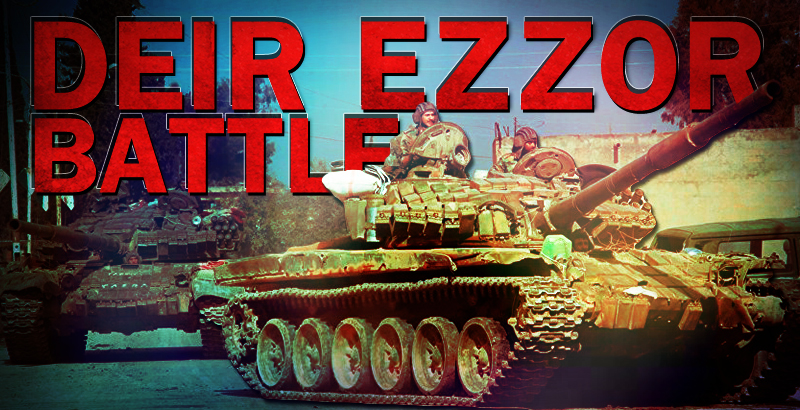
In September-October 2017, the Syrian Arab Army (SAA) and its allies broke the ISIS siege on Deir Ezzor city and liberated it as well as established control over the cities of al-Bukamal and al-Mayadin in the same province. The SAA operation in Deir Ezzor province marked a final phase of the war on ISIS as the Syrian-Iranian-Russian alliance and US-led forces are finishing the vestiges of terrorist group in eastern Syria.
In Deir Ezzor city, the SAA and civilians were fighting against ISIS in encirclement for over three years. The situation in Deir Ezzor impacted significantly the entire conflict and was one of the key battles in the war. Let’s look at the story in details.
The text below is updated and expanded version of SouthFront’s analysis entitled “The Stronghold of Deir Ezzor: All What You Need To Know About The Battle Against ISIS In Eastern Syria”, which was released on December 1, 2016.
The city is the seventh largest in Syria by population, according to 2012 data, when some 240 thousand people lived there. The Syrians themselves call it the “pearl of the desert.” It’s a large tourist and cultural center of the country. It’s also the center of an agricultural region with well-developed cattle herding, cotton cultivation, and other plant cultures. But it is first and foremost Syria’s oil extraction center. The Deir Ezzor province is home to Syria’s largest oil deposit, the Al-Omar. For ISIS, the city and the province are of particular value since the deposits there contain the highly valuable light sweet crude usable in the production of gasoline and diesel fuel, even using homebrew methods. As of October 2015, ISIS extracted up to 40 thousand barrels of crude a day. The largest Al-Tanak oil fields yielded up to 12 thousand barrels a day, while Al-Omar produced up to 9 thousand barrels of top-quality crude.
In addition, Deir Ezzor is a junction for roads which connect Syria’s cities to neighboring Iraq. Deir Ezzor airport, located south of the city, is a joint-basing airfield as it is home not only to civil aviation but also Syria’s air force.
The blockade and liberation
The situation in Deir Ezzor began to deteriorate when, following Friday prayers on the eve of Ramadan in late July 2011, unknown individuals dressed in military uniforms, opened fire on civilians. Subsequently the city saw protests demanding Bashar Assad’s resignation. In order to restore calm, troops were dispatched to the province. That’s when combat operations of varying intensity began in the city and the province.
By the fall of 2012, FSA and their situational ally Al-Nusra (or Al-Qaeda) controlled 90% of the province. This was not by accident. The long columns of tankers with high-quality Syrian crude would regularly head toward the border with Turkey.
In early 2013, the rebels seized oil fields of the province, and are able to enter neighboring Hasaka province (north-eastern Syria).
By May 2013, the rebels controlled half the city, while the military held the other half, the city’s military facility, and some of the oil industry.
In August 2013, the rebels launched a large-scale offensive which was met by an SAA counter-attack. But by October government forces were ejected from the city.
In November 2013, the rebels seized Syria’s largest oil deposit, Al-Omar. Since then the government has been totally dependent on petroleum product imports. By the end of the year, the rebels had seized control of nearly all the oil fields.
The fighting’s epicenter then moved toward the western reaches of Deir Ezzor, the suburbs which separate it from the airport.
Starting in early 2014, the tensions among various rebel factions (al-Nusra, Jaysh al-Islam, Haraka Ahrar Sham, the remnants of FSA, and other brigades which united into the Mejlis of Eastern Mujahedeen Shura), and those forces that declared themselves the Islamic State (ISIS).
On February 10, 2014, ISIS, in the face of the numerical superiority of al-Qaeda, FSA, and other groups seeking to capture the rich oil deposits, was forced to leave Deir Ezzor and focus its forces on Hasaka and Raqqa.
ISIS’ successful ops in Iraq in June 2014 allowed them to seize large quantities of munitions, modern weapons, and Western equipment. Some of that was immediately sent to Syria, to territories controlled by ISIS. This gave them a clear tactical superiority over both government forces and other rebels.
On July 14, 2014, after the killing of one of the local al-Nusra units, ISIS forced rebels to leave Deir Ezzor. On Sepbember 3, ISIS undertook its first independent attempt to take the airport. The SAA was able to repel the attack with the help of air support.
On September 15, 2014, government forces’ combat engineers blew up the last remaining Siyasiyeh bridge across the Euphrates that was used to resupply ISIS units. On November 12, the 104th Airborne Brigade took control of the Sakr island within the confines of the city following intense fighting. They discovered a small tunnel network built by local inhabitants forced to do so by the IS. Inside were large quantities of medications and surgical equipment. Durign the December 2014 offensive (which lasted from December 3 through 10), the militants took part of the village of Al Jafra and the rocket artillery battalion positions to the north-east of the city. They were not able to take the Turdah hill south of the airport.
Between January 16 and 21, 2016, ISIS militants launched an assault on the city from the north, east, and south. A group of militants sent six suiciders who tried to break through the checkpoints in the suburbs, but without success. ISIS launched several additional in the course of one day. In spite of desperate SAA resistance, ISIS took Al-Bughayliya and Ayyash suburbs, and the Al-Mariyah farms. Independent sources reported the death of 330 civilians and over 90 soldiers, while 400 military family members were taken captive. The militants lost over 350 killed during the offensive.
In September, 2016, the situation became especially complicated in the city after the US-led coalition bombed Syrian troops defending it. ISIS used this to launch a large-scale attack and captured a number of areas. Next months, the SAA fiercely resisted to the steadily advancing ISIS force.
During the five years of fighting the two sides’ losses, according to various estimates, have reached 3,000 militants (including ISIS), and 2,500 SAA troops. According to the most conservative estimates, about 1000 civilians perished. When assessing losses, one must keep in mind that each of the warring parties exaggerates enemy losses and under-reports their own in order to use these reports of own successes and enemy defeats as propaganda. While military and civilian losses on government-controlled territory are tracked by the Syria Central Statistics Bureau, ISIS and civilian casualties on ISIS-controlled territory are tracked by various foundations and organizations hostile to the Assad government. These organizations are mostly financed and organized by the US and its allies. Therefore it’s difficult to speak of an objective data collection operation.
In August 2017, the SAA launched a long awaited operation to lift the ISIS siege on Deir Ezzor city. After a rapid advance, a series of tactical maneuvers, including an air landing operation north of al-Sukhnah town on August 12, 2017, the SAA and its allies captured the al-Sukhnah-Deir Ezzor highway and effectively broke the ISIS siege on the city on September 5, 2017.
On September 23, 2017, the Tiger Forces captured the northwestern Deir Ezzor countryside and the southeastern Raqqa countryside fully securing the Raqqa-Deir Ezzor highway. Later in October, the SAA repelled a series of wide-scale ISIS attacks on its position on al-Sukhnah-Deir Ezzor highway securing this important supply line to troops and civilians in Deir Ezzor.
The ISIS weakness was clearly shown when the SAA and Tiger Forces captured Mayadin city on October 17, 2017. The operation took only 13 days.
After capturing Mayadin, the SAA and Tiger forces launched an offensive to recapture the remaining ISIS-held districts in Deir Ezzor city. Government troops captured Saqr Island on October 26 besieging ISIS inside few district in the center of Deir Ezzor. Suffering from major losses and unwilling to fight, ISIS fighters were quickly defeated inside the city. On November 3, 2017, the SAA captured the rest of district, which had been under the ISIS control.
The last ISIS stronghold in Syria, al-Bukamal city, was liberated by the SAA and its allies on November 8, 2017. The SAA and Hezbollah launched their attack on the city on October 13. The al-Bukamal operation was a devastating blow to the terrorist group. ISIS’s self-proclaimed caliphate collapsed.
The warring parties, their tactical methods and combat strength
During the ISIS siege the SAA had around 5000 troops inside Deir Ezzor city and airport. While it is believed that ISIS has between 7000 and 10000 fighters in Deir Ezzor governorate.
The 104th Airborne Brigade, part of the SAA’s elite Republican Guard, was the core of the city’s defense. SAA forces also included units of the 137th and 123rd Mechanized Brigades, local militia units, parts of the 119th and 71st Regiments, 8th Air Force Squadron (10 MiG-21s and some Mi-8/17s, Mi-25s) at the Deir Ezzor airbase. The 104th is supported by the 819th Squadron equipped with Su-24M2 bombers. The defense was led by 104th commander, Major General Issam Zahreddine, who was killed in action on October 18,2017. SAA forces were also assisted by Hezbollah units, which were almost fully ignored in the media coverage of the battle.
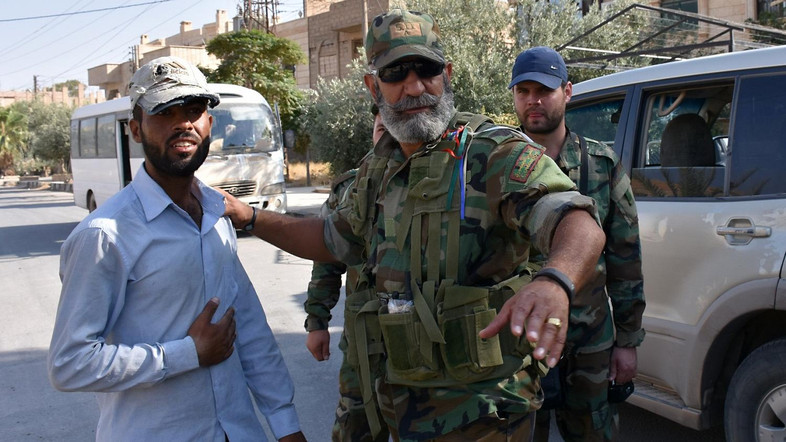
Issam Zahreddine (R) Major General of the Syrian Republican Guard, talks with a civilian in the eastern city of Deir Ezzor on September 10, 2017. AFP PHOTO / George OURFALIAN
During 2016, combat operations followed a certain pattern. The militants launched attacks from al-Jafra farms and al-Mariiyah, from the south and east of the airfield. The SAA, with an air and artillery support, repelled these attacks. Then, the both sides returned to their original positions. This story was repeated many times.
We can examine tactical methods used on the basis of the reports from a single day of fighting. For example, on November 23, 2016, SAA units once again repelled a powerful ISIS attack on the airport. The battle lasted six hours and ended with a clear SAA victory. The terrorists struck airbase’s southern perimeter from the nearby farms. Moreover, Jafra farms, where there are SAA positions, also came under attack. Positions were initially approached with armored suicide vehicle bombs, followed by militants whose task was to identify SAA firing positions. These positions were then attacked by ISIS snipers. Massed ISIS attacks were broken up by artillery, mortars, and large-caliber machine-gun fire.
Government forces prevented the enemy from entering into close combat, instead breaking up his formations at long ranges. Over 30 jihadists perished in this battle. Among them were mercenaries from Egypt, Saudi Arabia, and Morocco. After the failed ISIS attack, SAA troops conducted a sweep.
Moreover, the city itself was the site of active mine war. The SAA special purpose unit known as the al-Qasim group, conducted an operation on November 20, 2016, in order to destroy two large tunnels used by ISIS for supply. Syrian forces made a counter-mine from the direction of the al-Afri district and placed a powerful explosive under the tunnel. A second counter-mine was made in the neighboring Port Said district, where al-Qasim commanders decided to use the same tactic. As soon as the digs were completed, the explosives were detonated, killing dozens of jihadists and significantly damaging the infrastructure. The militants have made efforts to dig trenches and tunnels in the direction of SAA positions, but they have been effectively suppressed.
ISIS militants, cognizant of the city’s importance and the professionalism of its defenders, actively used suicide bombs, individual and vehicular. ISIS used drones to observe and even attack SAA positions. On October 29, 2014, SAA unit seized control of an ISIS drone forcing it to land within the city’s cemetery. On April 15, 2015, an ISIS drone was forced to land in a Deir Ezzor industrial park. An ISIS drone was shot down by ground fire on November 15, 2016, its wreckage falling near the old airport.
An event astounding in its cynicism took place on September 16, 2016. US-led coalition aircraft struck Syrian troops near the airport and the al-Tardah mountain. 62 SAA troops were killed instantly, and eventually reached 106, when counting those who died of their wounds by the end of the month, according to Al-Masdar News. The strike was carried out by two A-10 attack aircraft supported by two F-16 fighters. Tellingly, 7 minutes after the airstrike, ISIS attacked SAA positions on Al-Tardah and seized them. This temporal synchronization clearly indicates coordination between US airpower and ISIS militants. Nevertheless, by the end of the day the reaction by Russian and Syrian aircraft killed 38 militants, and the SAA ultimately retook the lost positions. Moreover, the SAA also captured the Tal Krum hill. A Syrian MiG was shot down by the militants. On September 18, the militants once again seized the hill, from where they posed an immediate threat to the airbase. ISIS also seized an artillery battalion base south of the airport. Due to this incident, the Syrian military was forced to redeploy over 1,000 Guard troops to Deir Ezzor area. This has led to a paradoxical situation—the SAA force defending Deir Ezzor is opposed by militants who are about equal in strength.
After breaking ISIS siege on Deir Ezzor city in September 2017, the SAA and its allies deployed several assault units to it, most notable the Tiger Forces. It’s believed that the SAA deployed more than 5,000 fresh fighters to the area by September. This high number of experienced fighters gave the SAA a numerical superiority for the first time since the armed conflict in Deir Ezzor started in 2012. Not only this, but also the urban warfare experience of the Tiger Forces was a vital factor during the clashes for Deir Ezzor and Mayadin, where the SAA countered ISIS defense tactics, which the terrorist group successfully used in Mosul and Raqqa.
The SAA 4th amoured division also deployed several special forces and armoured units in order to secure the al-Sukhnah – Deir Ezzor highway. Later the 4th armoured division spearheaded the SAA attack on the eastern bank of the Euphrates River, and was the first to cross it on September 18, 2017 with direct help from the Russian Military, which provided military advisors, an air cover and crossing equipment to insure the success of the operation.
Other groups like Tribal Forces and Liwa al-Quds played an important defense role and repelled several attacks of ISIS on the al-Sukhnah – Deir Ezzor highway in October 2017.
From its side, Hezbollah revealed that it has had a small special operations unit to boost the SAA defense inside Deir Ezzor airport since 2014. Hezbollah didn’t reveal the number of the unit. However, itis believed there were about 200 Hezbollah fighters.
The Hezbollah played its biggest role during the SAA advance on al-Bukamal, where over 1,500 fighters of Hezbollah spearheaded the SAA attack on the T-2 station and captured it on October 26, 2017. Later pro-government forces stormed al-Bukamal city and the Syrian Defense Ministry announced on November 9 that the city was liberated. The Hezbollah assistance made the attack on al-Bukamal possible sooner than it had been expected.
Humanitarian Situation
During the siege many of the city’s inhabitants died out of hunger or at the hands of terrorists. Nobody is counting the casualties among the civilians who were killed by ISIS and their predecessors such as the FSA and al-Qaeda. Deputy General Secretary of the UN Farhana Haka thusly commented the situation in Deir Ezzor before the siege was lifted: “Approximately 200 thousand people, mainly women and children, are in rapidly deteriorating circumstances in the besieged western part of Deir Ezzor in Syria. They need immediate humanitarian aid, including food and medicine. There are reports of extreme malnutrition and death of starvation.”
The UN also announced they are not able to establish regular aid supply to Deir Ezzor due to the intense battles which periodically erupt in the airport’s vicinity.
Nobody except Syria’s government and Russian airpower commanders is concerned with the starving in the city. Russian Military Transport Aviation aircraft alone delivered about 360 tons of food, medicine, clothes, and tents between January and August 2016. Syria’s transport aircraft also play an important role in maintaining supply. In their absence, the city would have been lost a long time ago, and it’s difficult to imagine what the militants would have done to its population. Overland communications have been cut a long time ago.
We’ll try to put ourselves in place of Syria’s government, which must address the task of supplying the besieged city.
This calculation is based on the specifics of Arab cuisine and the minimum daily nutrition requirements for adults. There are also children in the city, whose nutritional needs vary between 800 calories/day for newborns to 2800 calories/day for 15-18 year-olds. Their needs have not been accounted for in this estimate.

Therefore, the weight which has to be delivered on a daily basis amounts to 100,000 * 1kg, or 100 tons per day.
Military personnel as a rule have higher nutrition requirements of 3000 calories/day. If they use individual field rations delivered by Russia (each weighing 2kg), then 5,000 * 2kg = 10 tons per day. If they eat the same products that are consumed by civilians:

5000 individuals * 1,5kg = 7,5 tons per day.
Therefore, the total food demand amounts to 107.5 tons per day.
In addition to food, the city needs medicine, fuel, hygiene supplies, mail, and money, and of course munitions.
The main Syrian airbases capable of operating all types of transport aircraft supplying Deir Ezzor include Damascus and Tiyas (Homs province). Syria’s transport aviation includes Il-76M aircraft (three total), An-26 (6), and Mi-8 (about 50).

We’ll assume that Il-76M will fly from Damascus, with its huge warehouses, while An-26 and Mi-8 will operate from Tiyas.
Therefore, in order to satisfy the city’s food needs, one requires:
- Two Il-76M flights, each with 40 tons, plus two An-26 flights, each with 5.5 tons, and five Mi-8 flights, each with 4 tons, for a total of 111 tons.
- The Il-76Ms will expend 18 tons of fuel, An-26—2.6 tons, Mi-8—8 tons, for a total of 28.6 tons of fuel.
According to IATA, aviation fuel in the Middle East and Africa as of November 18, 2016, costs $432.ton. Therefore 28.6 tons require the expenditure of $12,355 tons per day. In actuality, the cost of fuel is higher.
These calculations do not include the cost of aircraft maintenance, airbase services, salaries. Moreover, one has to consider the time needed to load and unload the aircraft. In ideal conditions, even if an Il-76 lands at Deir Ezzor, its unloading would take half a day. Until it’s completed, there is no sense in sending another aircraft. Moreover, Syrian aircraft are heavily used up, so their transports cannot fly every day. Therefore the air supply is ensured by Mi-8 helicopters.
Considering the above calculations, there are reasons to believe that there was an unwritten agreement between besieged population, population under ISIS rule, and ISIS militants, which partly relieved the government of the responsibility to feed the population during the siege in return for a monetary payment. There should be no problem with that. As noted above, Deir Ezzor is a major agricultural center. Syria’s government turns to the Russian Air Force for help only in extreme circumstances.
Evidence supporting this supposition includes the fact that, between January and February 2016, Russian transport aircraft airdropped 250 tons of food and medicine. Then there was a break in large-scale drops, and then, starting with July 8, 2016, airdrops resumed with an 18-ton drop and were followed by 15 tons on August 3, 18 tons on August 11, 21 tons on August 19, 20 tons on August 25, and 17 tons on August 26. There are no reports concerning aidrops between September through October. It is possible to sustain the military force with food, fuel, and munitions using Mi-8s.
After the siege was broken the Syrian government, Iran and Russia quickly started a large-scale operation to provide humanitarian aid for Deir Ezzor civilians via the al-Sukhnah–Deir Ezzor highway, and the Homs–Raqqa–Deir Ezzor highway, which were secured by the SAA. The aid had a direct positive impact on the humanitarian situation in Deir Ezzor city.
The situation become way better when the SAA allowed civilian shipping companies to use the highways. Thus, Deir Ezzor markets were flooded with all kind of goods, which were supplied to the city by the Syrian government, local merchants and companies from the private sector. The prices in Deir Ezzor became more or less the same like in any other government-held area across Syria. On November 8, 2017, the Syrian government announced that a public transportation services will be resumed from and to Deir Ezzor city. Before this, civilians were allowed to go out and enter the city only via privately owned vehicles.
At least a part of the negative effects of Deir Ezzor siege were removed, and the civilians in Deir Ezzor city became able to resume their peaceful life.
Conclusion
With ISIS controlling only few villages and town in the southeastern Deir Ezzor countryside, the battle in Deir Ezzor governorate will likely be over before the end of 2017. However, ISIS fighters, who would be able to withdraw towards the Homs desert, will remain a threat to the SAA and the liberated areas in the province. The SAA will likely need months to eliminate these fighters in the desert.
However, the fierce battle between the SAA and ISIS gave the US-backed Syrian Democratic Force (SDF) enough time to capture most of the Deir Ezzor oil fields, including the strategic Omar oil fields, on the eastern bank of the Euphrates. This created tensions between the SAA and the SDF. Government supporters believe that the US-led coalition and the SDF just made a series of deals with ISIS-linked tribes and seized the key infrastructure while the SAA was fighting a key ISIS force on the western bank of Euphrates.
Now, the both sides appear to be unwilling to reach any political agreement. Instead, they prefer to accuse each other of cooperating with ISIS. Many statements of officials from Syria and Iran indicated that the SAA is still willing to capture the oil fields even if it has to fight the SDF and the US troops in Syria.
A lack of political cooperation between the SDF and the government creates a foothold for new series of armed hostilities in eastern Syria, which may begin in Deir Ezzor province.



